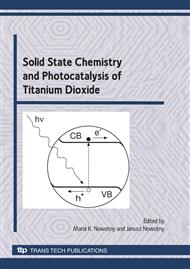p.1
p.29
p.41
p.49
p.77
p.91
p.115
p.135
Investigations of Photo-Excited TiO2 Based on Time Resolved Microwave Conductivity and Oxygen Isotopic Exchange
Abstract:
Charge recombination is the main drawback of heterogeneous photocatalysis; it considerably limits the applications. Consequently, it is of paramount importance to study this process. Time resolved microwave conductivity (TRMC) is an appropriate technique for that purpose since it allows measurements without electrical contacts. Here are presented and discussed results obtained by TRMC for TiO2 powders. They indicate the importance of the TiO2 particle diameter in determining the conductivity. The attraction of TiO2 photoproduced electrons to deposited Pt particles was also shown by TRMC, as well as the very rapid charge recombination in TiO2 homogeneously doped with 0.85 ion % of Cr3+ cations. TRMC measurements for TiO2 affixed on thin fiberglass tissues using SiO2 as a binder demonstrated that TRMC is also adapted to composite materials; the type of SiO2 had only a secondary influence on the conductivity. Additionally, the effects of alcohols were investigated by TRMC to illustrate the occurrence of interfacial charge transfer. On the other hand, oxygen isotope exchange (OIE) of gaseous 18O2 occurs over photo-excited Ti16O2. It is believed to be facilitated by surface irregularities which can thus be probed. OIE measurements in the presence of compounds whose photocatalytic oxidation primary step requires the incorporation of an O atom suggested that labile O atoms of TiO2 do not play the dominant role. Contrasted effects on OIE and photocatalytic removal of methanol in air showed (i) the influence of thermal treatment on TiO2 surface re-structuring (ii) the preferential adsorption and subsequent UV-induced reduction of Se salts at more labile surface O atoms.
Info:
Periodical:
Pages:
41-48
Citation:
Online since:
June 2010
Authors:
Price:
Сopyright:
© 2010 Trans Tech Publications Ltd. All Rights Reserved
Share:
Citation:


